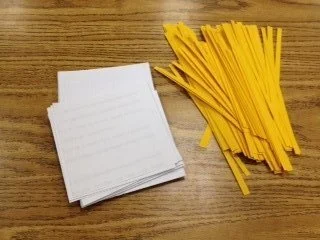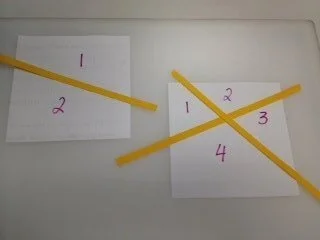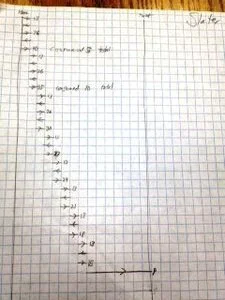My Other Math Sites
Lessons From the Classroom
Foxy Fives - Cuz It’s Better Than Four Fours
Foxy Fives is my Day 21 lesson (actually a game) that I got from this book. The teacher is supposed to make a deck of 62 cards from poster board—the cards are numbered 1 to 25—and blah, blah, blah. For the life of me, I don’t know why you’d need a deck of cards at all to play this game, because the instructions TELL YOU to deal yourself a specific set of cards for each round, like cards numbered 1, 5, 3, 6, and 10.
There. I just dealt myself a hand.
Other than that ridiculousness, it’s actually a great lesson for students to apply the order of operations to a set of numbers. The game has three sheets. And just for you, I completely retyped them to remove the silly language about dealing out cards.
Here are:
Foxy Fives Sheet 2 — I save these for my 6th graders.
Foxy Fives Sheet 3 — The 8th graders get this more challenging (thus, more fun) version.
I had kids work in groups of three on the large whiteboards.
You can tell from Sheet 3 that it’s asking the kids for more. It’s great to do this after we’ve just discussed number systems.
The kids struggled and struggled. (Quite a lovely thing to bear witness to.)
Most groups found a couple. One group found the first five!
Also, I was very clear about them reporting their answers like this:
And not like this:
My next plan is to put each of the 10 questions onto large poster paper and hang them around the room. I’ll encourage kids to contribute their solutions to each problem over time. It’s good for them to see that there are many solutions possible. And they can also check others’ work for correctness!
Such a Nguyen-Nguyen if I ever saw one.
(When I left a local high school position, the students' newspaper did a story on me. They titled it, "Students Find Themselves in a No Nguyen Situation." So cute.)
Last Math Lessons
On the first day of school, I promised all my students that I'd do my best to make math relevant and challenging. I also promised to never waste their time, therefore they could expect to do math every day in my class, including the last day of class.
I did not promise them that math would be fun because doing math is always fun to me. I gave out math puzzles at my kids' birthday parties when they were younger, also at a baby shower that I gave, and of course at my own wedding.
Math 6
I called this lesson How Many Regions? (Adapted from AIMS)
I gave each student a piece of 4-by-4-inch paper and a handful of 6-inch long thin strips of construction paper. Each strip placed on the square paper would represent a "cut."
Question: What is the maximum number of regions that you can divide the square into using n number of "cuts"?
We did the first two cuts together as a class, and each student kept track of the data in their journal.
Because the goal was to get the maximum number of regions from the cuts, the kids learned quickly that the cuts needed to intersect. For example, two non-intersecting cuts created only 3 regions. A kid yelled out, "Parallel cuts!" Gotta forgive kids who blurt out academic language!
This class has been working with a pattern worksheet almost every Monday in my class, so they know to look for a recursive rule and try to find the equation for the nth term. Recursively, they saw the pattern, so it didn't take long for them to figure out that for any n (cuts), the maximum number of regions is the sum of n and the number of regions from the previous n.
With 30 seconds left of class, I told them my gift to them was to try and figure out the equation. Matt asked, "Can I email you then over the summer?"
Algebra 1
Our 8th graders' last day of classes was yesterday (Wednesday). They'll show up this evening for their promotional ceremony, dressed to the hilt.
I needed a quick one-period lesson, so I had them make 2012 Clocks. This is a common assignment: using all 4 digits in "2012" and each digit only once, they had to create expressions that would equal to the hours of 1 through 12 on a clock.
Geometry
I've seen different versions of this problem; the first time I worked on it was when it involved 3,000 bananas and 1 camel traveling 1,000 miles. I know there's a perfectly good strategy called "solve a simpler problem," but we could also start with a simpler one!
I gave my kids Desert Crossing, also from AIMS:
You live in a desert oasis and grow miniature watermelons that are worth a great deal of money, if you can get them to the market 15 kilometers away across the desert. Your harvest this year is 45 melons, but you have no way to get them to the market, except to carry them across the desert. You have a backpack that holds up to 15 melons, the maximum number that you can carry at a time. To walk across the desert, you need a certain amount of fluid and nourishment that is supplied by the melons you carry. For each kilometer you walk (in either direction), one melon must be eaten.Your challenge is to find a way to get as many melons as possible to market.
As I type this, Slater does not know that I will be awarding him the Math Excellence Award at the Promotional Ceremony this evening.
Here is Slater's work that shows one way to get the correct answer of 8 watermelons.
I did this a few weeks ago and forgot all about it; so here's a little blurb on it.Each student quickly constructed these two prisms from two same size papers.
(Dan Meyer folded them into cylinders.)
Question: Pretend the two prisms have bottoms on them, which one holds more popcorn? Take a look... Okay, grab the one you think holds more, or grab both if you think they're both equal.
And this was how they grabbed:
Then they measured and calculated the volume.
My favorite student comment: The tallness didn't make up for the fatness.
Estimating volume is a funny thing.











